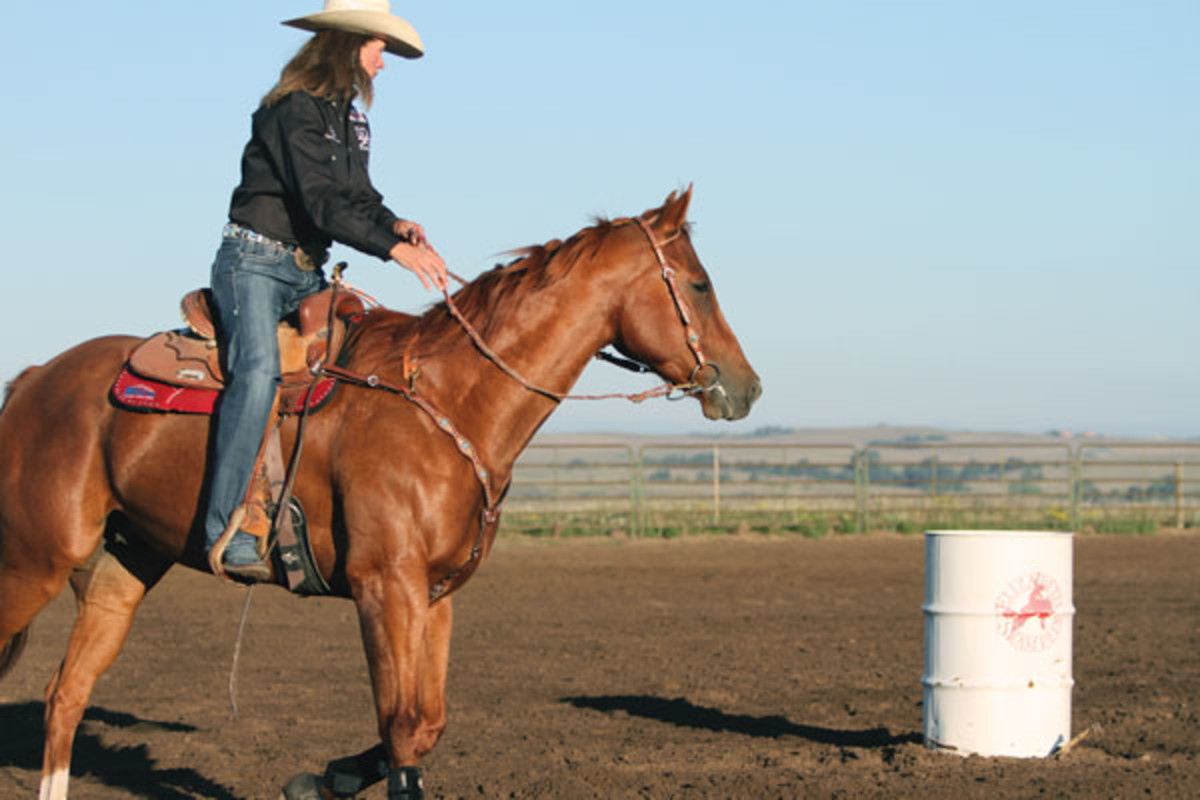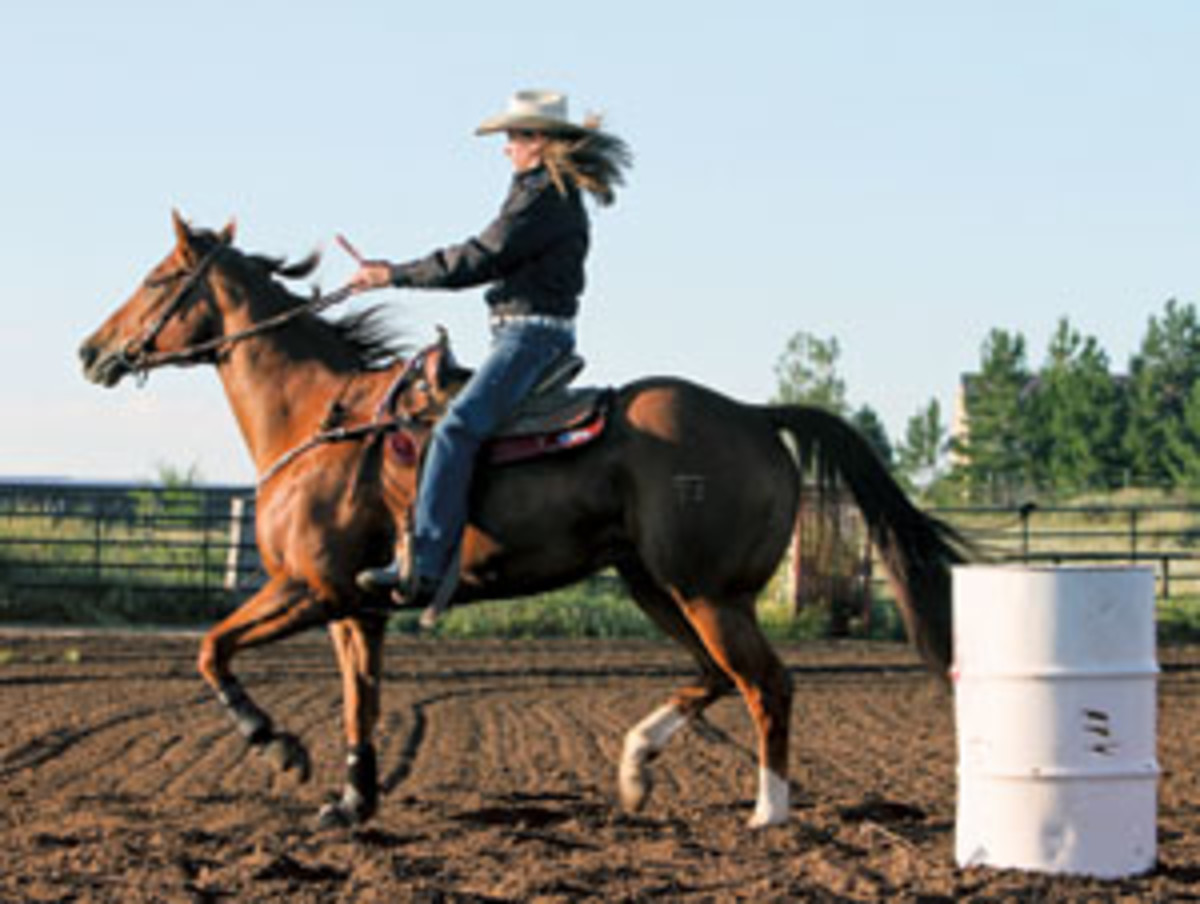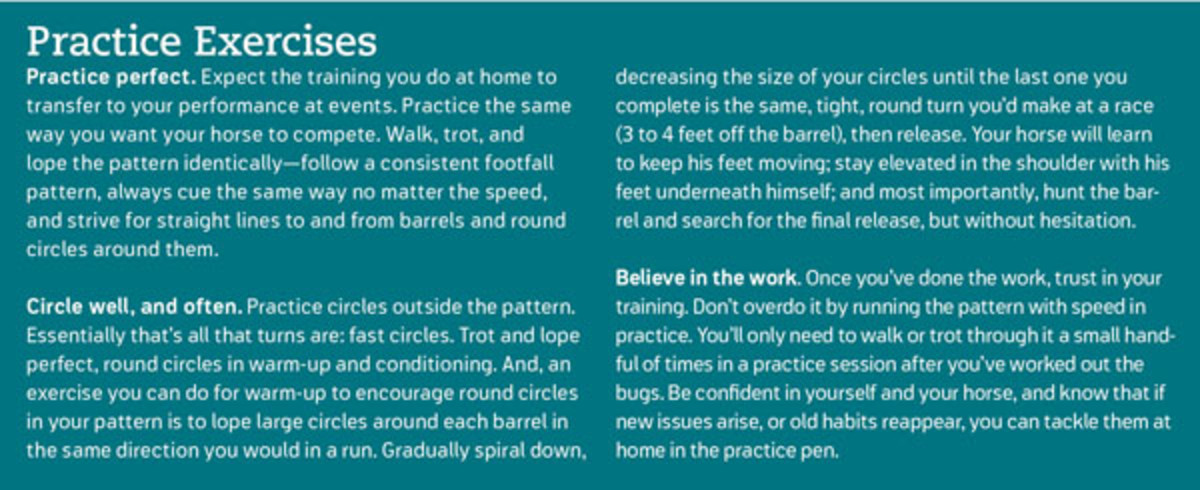Speed, check. First turn, check. Second, “look out!”

OK, so you have trouble at the second barrel of a cloverleaf pattern, and you can’t figure out why. No sweat: Speed competitors often find themselves with a trouble spot somewhere in their pattern, so rest assured that you’re not alone.
One reason why the second barrel is tricky is because it’s sometimes set extra-close to the fence, with flapping arena banners, a row of waiting horses, or a cheering crowd. This can intimidate and distract your horse, causing him to want to turn too soon. The second barrel also creates the most exaggerated, 360-degree turn that you’ll face in the entire barrel pattern, making it even more difficult. Here, I’ll help you diagnose and fix the two likely issues you’re experiencing at the second barrel. I’ll also share some practice exercises that’ll keep your turns quick and crisp.
Barrel-Blues Initiator #1: Too Soon to Turn
You might have difficulty at the second barrel in small or indoor pens, or when the pattern is set up close to the perimeter of the arena, because your horse feels claustrophobic. He sees the looming barrier and tries to rate, or slow from a full-stride run to a more manageable speed, to prepare to turn the barrel.

The issue: When a horse anticipates a turn by slowing down before your cue, he’s more likely to hit and knock over the barrel. At best, if he misses it, he’ll be forced to cover more ground on the backside, or far side of the barrel closest to the arena perimeter and entrance. These compensations put you in a poor position to depart to the third barrel, costing you valuable time in your run.
In practice, you might tend to stop your horse a stride away from the barrel, with the idea of teaching him to slow down before the turn. This could be part of your undoing. For horses that are sensitive to close barriers or naturally hunt a barrel and want to slow down, you must keep their feet moving, and most importantly, keep them listening to you. (Check out “Practice Exercises” on page 52, for a better method to teach rate.)
The solution: Make sure you ride your horse all the way to the barrel. Rather than drop to the horn and steer-one handed midway between first and second, consciously drive your horse into position by keeping both hands on the reins. Here’s a drill that’ll help you keep your horse tuned in to your cues, and keep him from hesitating at the second barrel.
• First, complete your first turn and head straight to the pocket of your second barrel. (The pocket refers to the area around the barrel where you’ll complete your turn.) Keep two hands on the reins and your body in a drive position, rather than hunched and heavy in the saddle, which is his cue to turn.
• Instead of turning when you reach the barrel, drive your horse straight past it and to the fence. (Note: If you practice in a large arena, there’s no need to ride to a fence that’s 30 feet away. But, do take him far enough past the barrel that he doesn’t think, “turn.”) Don’t let your horse break stride or hesitate. Instead, focus on forward motion, but stay quiet about it—any hand-jerking or kicking will increase anxiety and defeat the purpose of the exercise. You don’t want him to think faster just, “wait.”
• Complete the drill a couple times before taking your horse through the full pattern, this time with a complete turn at the second barrel. He should listen for your cue to continue straight or turn, but if he hesitates, try the exercise again.
The goal is to have your horse solid enough in the pattern that he’ll easily execute it in a competitive arena so you can focus on cueing, guiding, and encouraging him. Yet you also want to ensure that he knows that you’re the driver. He needs to listen for your cues because conditions change sometimes, causing you to need to make slight adjustments mid-run. You don’t want to feel like you’re just along for the ride.
If you fix the problem at home and it re-appears at a race, haul your horse to an exhibition or a friend’s arena to practice the same passing-the-barrel exercise in a new environment. Also, learn your horse’s style. This way, when you go compete you can take special care to ride two-handed and drive to the pocket until you’re ready to turn.
Barrel-Blues Initiator #2: Poor Approach
Because the second barrel requires you to execute the most complete turn in the pattern, an efficient and well-planned approach is non-negotiable. You could lose valuable time, swinging out too widely off the backside, or losing power and momentum just because your approach is too wide or you cue too soon for a turn.

The issue: When you fall victim to the “question mark” approach, where you swing out toward the end of the arena before taking your turn, you’re doing two things to slow down your run. The first is you simply cover unnecessary ground, which costs time. The second is that you teach your horse to dive toward the barrel to make the turn rather than keep his shoulder elevated, which causes his legs to swing out and compromises your desired round, powerful turn.
If you come in straight but try to turn too soon, your horse has to travel farther around the backside to complete the full turn. You’ll swing out wide at the end of the turn, costing you time and putting you in a poor position to approach your third barrel. (Reminder: Straight lines are the quickest, shortest distance between two points, so you should strive to keep your runs between barrels as straight as possible.)

The solution: Remain straight for as long as possible into the pocket of your second barrel. Keep a 3- to 5-foot space between the barrel and your horse as you approach, a good rule of thumb for your entire turn. Resist the urge to sit down and cue for the turn until your horse’s front leg is just a quarter-step past the barrel. You might panic and think it’s too late at this point. But, maintaining a straighter line deep into the pocket will actually allow your horse to get his body past the barrel, and in position to make a nice, round circle instead of an oblong or oval-shaped turn. Now, sit down deeply in the saddle; drop your outside rein, and use your free hand to grab and brace against your horn to ensure that you’re secure in the seat of the saddle; and ask for his nose while keeping his shoulder elevated. This is his cue to make the quick, powerful turn that you’ve set him up for perfectly.
Darla Kennepohl lives in Kiowa, Colorado, where she owns and operates SDK Barrel Horses. She is a two-time AQHA World and Reserve World Champion, Jim Nordick Coliseum arena record-holder, Barrel Futurities of America World Champion, and accomplished futurity horse trainer. She prides herself in training quiet, talented athletes that compete with a willing attitude.






